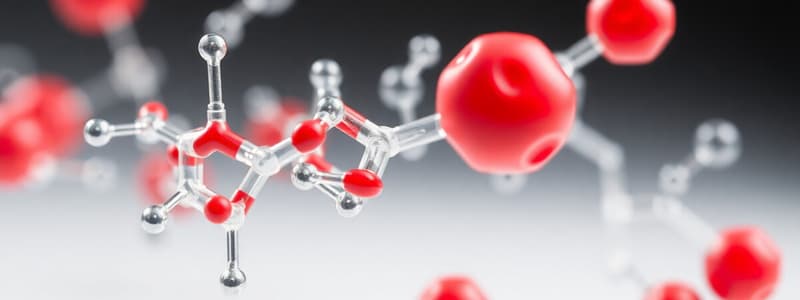Podcast
Questions and Answers
What role do inhibitors play in enzyme activity?
What role do inhibitors play in enzyme activity?
- They enhance the reaction rate.
- They prevent the enzyme from catalyzing reactions. (correct)
- They increase substrate availability.
- They permanently alter the enzyme structure.
What is the primary difference between competitive and non-competitive inhibition?
What is the primary difference between competitive and non-competitive inhibition?
- Non-competitive inhibitors bind to the substrate, while competitive inhibitors do not.
- Competitive inhibitors can enhance enzyme activity.
- Competitive inhibitors bind to the active site, while non-competitive inhibitors do not. (correct)
- Only non-competitive inhibitors can be reversible.
What happens to the reaction rate as the concentration of a competitive inhibitor increases?
What happens to the reaction rate as the concentration of a competitive inhibitor increases?
- The reaction rate increases significantly.
- The reaction rate remains the same regardless of inhibitor concentration.
- The reaction rate fluctuates randomly.
- The reaction rate decreases until it stops completely. (correct)
How does non-competitive inhibition affect enzyme functionality?
How does non-competitive inhibition affect enzyme functionality?
Which of the following statements about reversible inhibitors is true?
Which of the following statements about reversible inhibitors is true?
What is the effect of a non-competitive inhibitor on the saturation curve of an enzyme?
What is the effect of a non-competitive inhibitor on the saturation curve of an enzyme?
What can be a necessary role of inhibitors in the human body?
What can be a necessary role of inhibitors in the human body?
Which characteristic of irreversible inhibition is true?
Which characteristic of irreversible inhibition is true?
What occurs when an irreversible inhibitor binds to an enzyme?
What occurs when an irreversible inhibitor binds to an enzyme?
What is the role of an allosteric activator?
What is the role of an allosteric activator?
How does feedback inhibition impact enzymatic reactions in a metabolic pathway?
How does feedback inhibition impact enzymatic reactions in a metabolic pathway?
Where is the allosteric site located on an enzyme?
Where is the allosteric site located on an enzyme?
What happens to threonine deaminase when isoleucine accumulates?
What happens to threonine deaminase when isoleucine accumulates?
What is the classification of a regulator that stabilizes the conformation lacking an active site?
What is the classification of a regulator that stabilizes the conformation lacking an active site?
Which statement accurately describes the oscillation of allosteric enzymes?
Which statement accurately describes the oscillation of allosteric enzymes?
What signifies a product's role in feedback inhibition of a metabolic pathway?
What signifies a product's role in feedback inhibition of a metabolic pathway?
Flashcards
What is an inhibitor?
What is an inhibitor?
A molecule that binds to an enzyme and prevents it from catalyzing reactions.
What is competitive inhibition?
What is competitive inhibition?
Inhibitor binds to the same site as the substrate, blocking the substrate from entering the active site.
How does a competitive inhibitor affect the reaction rate?
How does a competitive inhibitor affect the reaction rate?
The reaction slows down or stops because the inhibitor effectively blocks the active site from interacting with the substrate.
What is non-competitive inhibition?
What is non-competitive inhibition?
Signup and view all the flashcards
How does a non-competitive inhibitor affect the binding efficiency of the enzyme?
How does a non-competitive inhibitor affect the binding efficiency of the enzyme?
Signup and view all the flashcards
How does a non-competitive inhibitor affect the saturation curve?
How does a non-competitive inhibitor affect the saturation curve?
Signup and view all the flashcards
What can be done to overcome competitive inhibition?
What can be done to overcome competitive inhibition?
Signup and view all the flashcards
Why do inhibitors naturally exist?
Why do inhibitors naturally exist?
Signup and view all the flashcards
What is an allosteric site?
What is an allosteric site?
Signup and view all the flashcards
What is an effector?
What is an effector?
Signup and view all the flashcards
What is allosteric control?
What is allosteric control?
Signup and view all the flashcards
What is an allosteric inhibitor?
What is an allosteric inhibitor?
Signup and view all the flashcards
What is an allosteric activator?
What is an allosteric activator?
Signup and view all the flashcards
What is feedback inhibition?
What is feedback inhibition?
Signup and view all the flashcards
What is negative feedback?
What is negative feedback?
Signup and view all the flashcards
What is irreversible inhibition?
What is irreversible inhibition?
Signup and view all the flashcards
Study Notes
Enzyme Regulation: Inhibition
- Inhibitors: Molecules that bind to an enzyme, preventing it from catalyzing reactions. They can block substrate access, slowing or stopping the reaction.
- Irreversible Inhibition: Occurs when the inhibitor forms covalent bonds with the enzyme, permanently disabling it.
- Reversible Inhibition: Occurs when the inhibitor's binding is weak and easily reversed. Common in metabolic regulation.
- Competitive Inhibition: The inhibitor binds to the same active site as the substrate. High inhibitor concentration stops the reaction completely as inhibitor and substrate compete.
Competitive Inhibition & Saturation Curves
- Competitive inhibitors alter the apparent Km (Michaelis constant) of the enzyme.
- By increasing the inhibitor concentration, the enzyme's affinity for substrate is reduced and the saturation curve shifts to the right, implying a greater substrate concentration is needed for the same reaction rate. Effectively higher Km.
Non-Competitive Inhibition & Saturation Curves
- Non-competitive inhibition: Inhibitors bind to a site other than the active site (allosteric site), changing the enzyme's shape and reducing its ability to bind the substrate.
- Non-competitive inhibitors alter the Vmax of the enzyme.
- Increasing the inhibitor concentration decreases the reaction rate (lower Vmax) regardless of substrate concentration.
- The saturation curve stays similar in shape just shifts down because the the maximum rate of the reaction is lowered.
Overcoming Competitive Inhibition
- Increasing substrate concentration can outcompete the inhibitor for the active site, restoring enzyme activity.
Importance of Inhibitors
- Inhibitors play a crucial regulatory role in metabolism, regulating the rates of biochemical pathways.
Reversible vs Irreversible Inhibition
- Reversible inhibition involves weak binding, allowing the inhibitor to detach and enzyme function to return.
- Irreversible inhibition involves strong covalent bonding, permanently disabling the target enzyme.
Allosteric Control on Enzyme Activity
- Allosteric Enzymes: Enzymes that have an allosteric site in addition to the active site. This site can be between subunits.
- Allosteric Site: A specific site on the enzyme (not the active site) where molecules (effectors) can bind.
- Allosteric sites have two conformations (active and inactive) that are in dynamic equilibrium.
- Binding to an allosteric site can stabilize either the active or inactive conformation.
- Effectors: Molecules (activators or inhibitors) that bind to allosteric sites, regulating enzyme activity.
Feedback Inhibition (Negative Feedback)
-
Feedback Inhibition: End-product(s) in a metabolic pathway regulate the first step of the pathway via an allosteric effect.
-
High product levels act as an inhibitor, slowing further reaction rates.
-
Low product level inhibits reduces the inhibition, increasing the rate.
-
Feedback inhibition is a form of regulation within pathways preventing unnecessary synthesis of materials, ensuring resources are efficiently used.
Studying That Suits You
Use AI to generate personalized quizzes and flashcards to suit your learning preferences.




